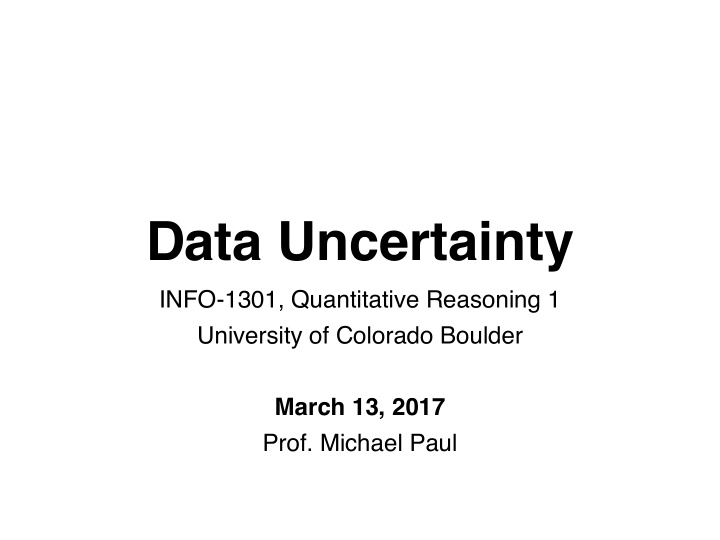



Data Uncertainty INFO-1301, Quantitative Reasoning 1 University of Colorado Boulder March 13, 2017 Prof. Michael Paul
Measurement Error When we construct data, how accurate are the values? How do we know? • I am 72 inches tall (to the nearest 1/8 inch) • My Subaru gets 22 miles per gallon on average (which is a 5% overestimate, on average!) • I do not have strep throat (according to a test that has a false negative rate of 10-20%)
Measurement Error “Even ¡simple ¡counts ¡break ¡down ¡when ¡you ¡have ¡to ¡ count ¡a ¡lot ¡of ¡things. ¡We’ve ¡all ¡sensed ¡that ¡ population ¡figures ¡are ¡somewhat ¡fictitious. ¡Are ¡ there ¡really ¡536,348 ¡people ¡in ¡your ¡hometown, ¡as ¡ the ¡number ¡on ¡the ¡‘Welcome ¡to ¡…’ ¡sign ¡suggests? ¡If ¡ the ¡sign ¡said ¡540,000 ¡we ¡would ¡know ¡to ¡treat ¡it ¡as ¡a ¡ rough ¡figure, ¡yet ¡far ¡too ¡often ¡we’re ¡willing ¡to ¡ imagine ¡that ¡every ¡last ¡digit ¡is ¡accurate.”
Measurement Error Common sources of error: • Limitations of measurement device (lab test, sensor) • Reliability of human feedback • Misrepresentation (intentional or unintentional) • Memory limitations • Misunderstanding or skipping a prompt • Sampling from a population • Size of sample • Bias in sample
Measurement Error Often one kind of error is Two types of errors: more harmful than the other • False positive • You incorrectly identified something as something • Ex: Test says you have strep, but you don’t • False negative • You incorrectly identified something as not something • Ex: Test says you don’t have strep, but you do Need to specify what is considered “positive” • Diagnostic tests • Screenings (e.g., security, quality control)
Quantifying Errors We can often assign a probability to different errors, and use this probability to communicate our certainty about how accurate a value is • For binary values (e.g., positive vs negative), probability of having a false positive and/or false negative • For continuous values (e.g., unemployment rate), probability of making an overestimate or underestimate of a certain value • Errors often form a bell curve, which we can use to quantify the probability of different sizes of errors
Sampling Error
Sampling Error
Sampling Error
Quantifying Errors A confidence interval (CI) is a range of values that the true value is most likely to be between The margin of error is the distance from the estimated value to boundaries of the confidence interval • Always half the width of the confidence interval (if the CI is symmetric) Ex: we are confidence that the true value is: • inside the interval (20, 60) ← This is the CI; Width of CI = 40 • 40 ± 20 ← Margin of error
Quantifying Errors Confidence intervals and margin of error tell you the size of the error We also need to express the probability that the error will be of that size The confidence level is the probability that: • the true value is within the confidence interval “the 85% confidence interval is (20, 60)” • the error in measuring the true value is at least as small as the margin of error “the margin of error is 20 at 85% confidence”
Confidence The size/width of a confidence interval depends on three factors: 1. The variability in your data • Don’t worry about this for now – we’ll see this mathematically later this month 2. The size of your sample • Larger sample → smaller confidence interval • Size of population does not affect your confidence interval (unless the size of population affects variability in #1) 3. The confidence level • Higher confidence level → wider confidence interval
Recommend
More recommend